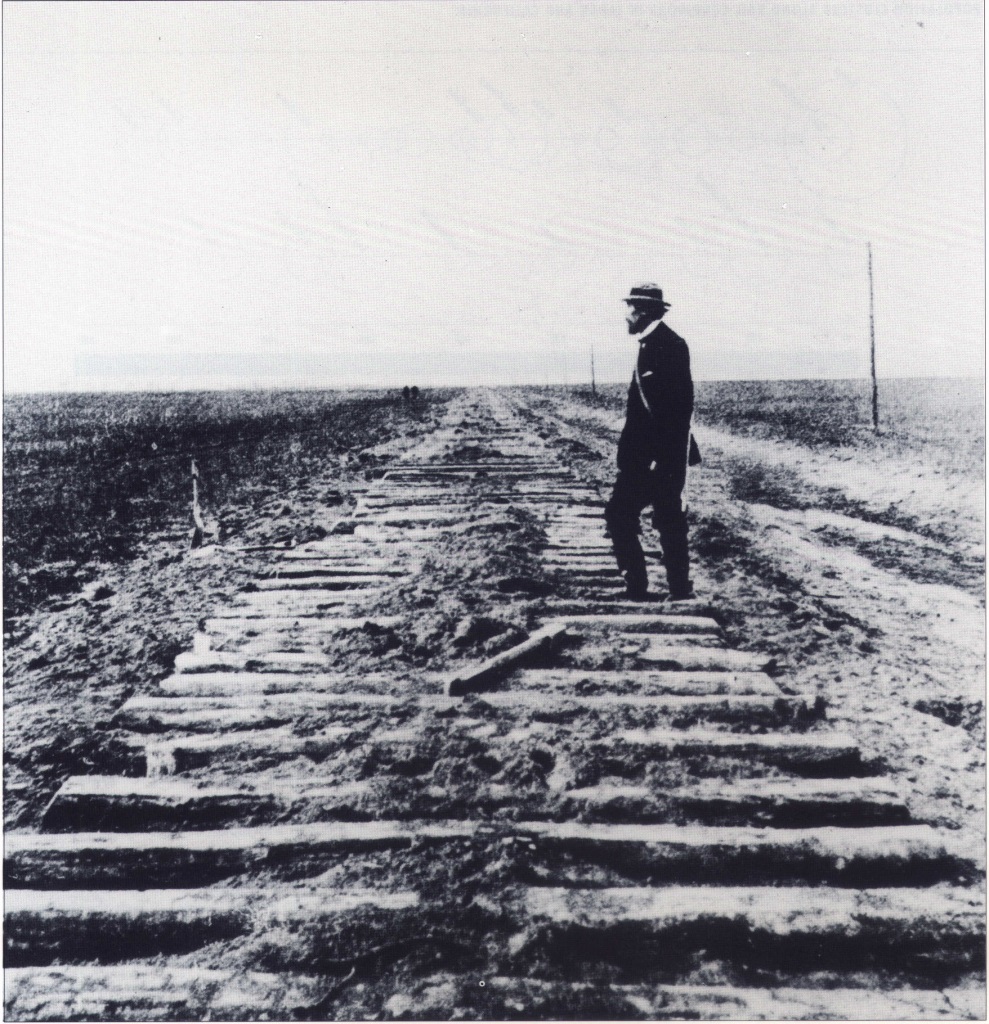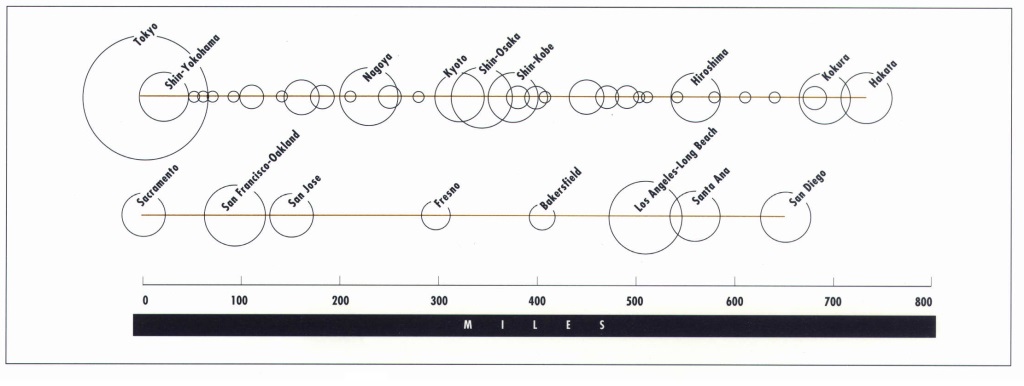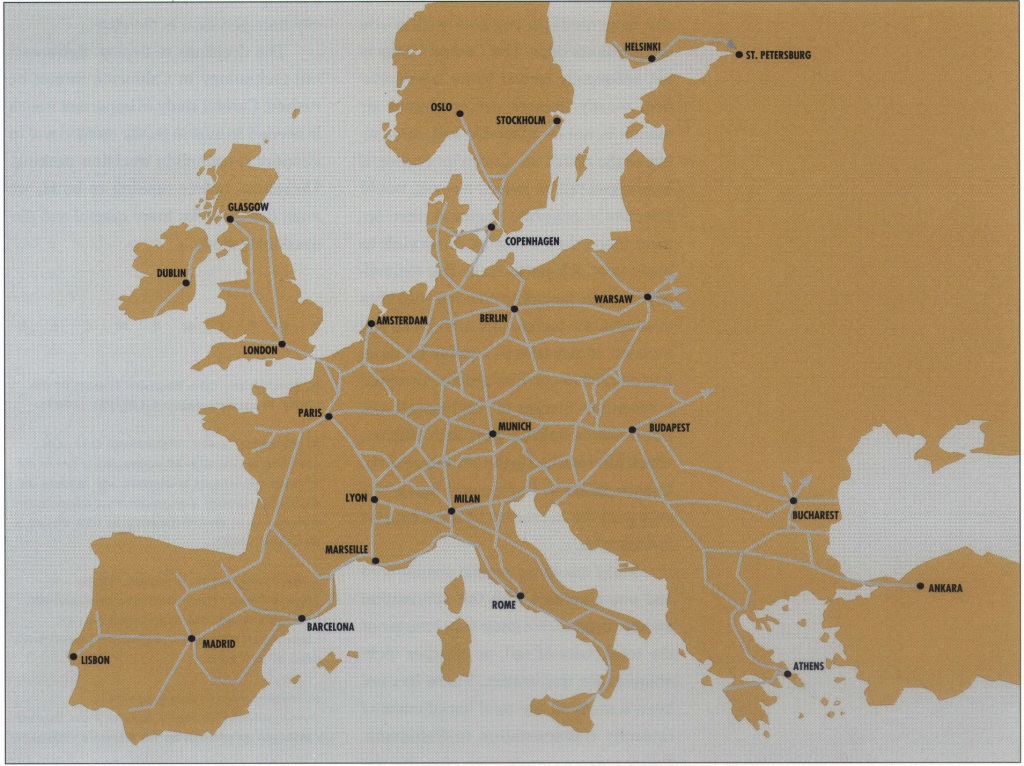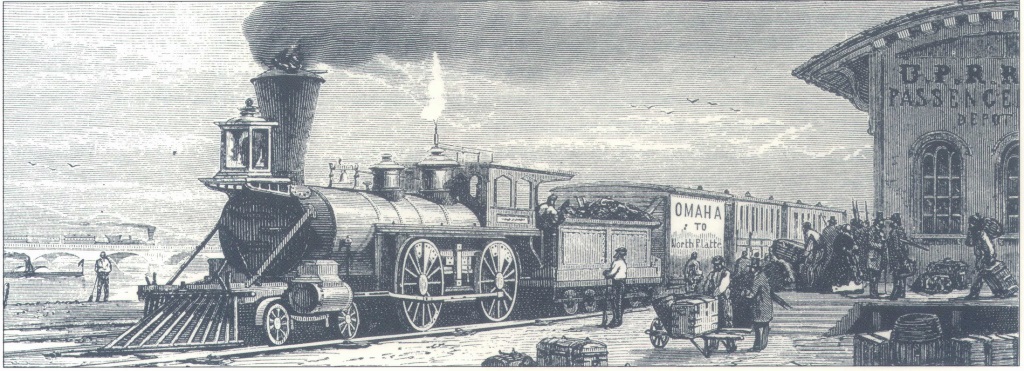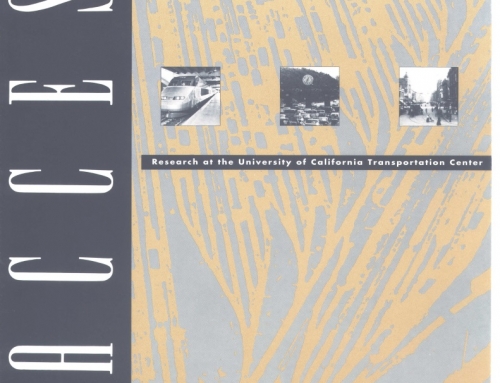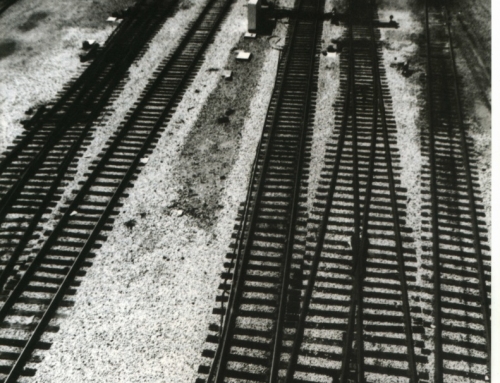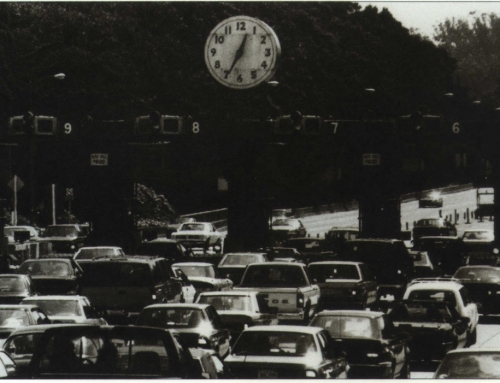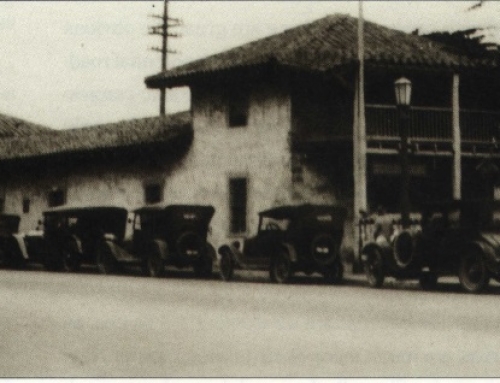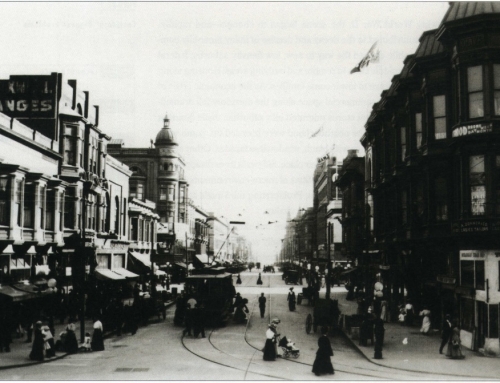There is little doubt that a high-speed rail line could be built in the California corridor, connecting San Francisco and Los Angeles. To be sure some major obstacles must be reckoned with. It will have to cross the Tehachapi Mountains directly, if it’s to keep travel time under control. This means some extensive and expensive tunneling. The large, low-density, and expansive metropolitan regions of the Los Angeles Basin and the San Francisco Bay Area will have to be penetrated by an exclusive, grade-separated rail system, which will also require some extensive urban construction. Nontechnical but equally tough obstacles would include possible opposition by communities along the corridor, especially in rural areas where the high-speed line would cut through but not serve.
Notwithstanding these obstacles, it’s fair to say that if we decided to build such a system, it could be built; and it could become a showcase of technological advancement. A high-speed rail system would permit passengers to ride in comfort for a journey between the two metropolitan regions, taking anywhere between three and five hours door to door. The rail line could carry as many passengers per hour as about 100 corridor flights, could consume about a third of the energy per passenger- mile that air or automobile trips use, and could generate only about a fifth of the automobile’s emissions and half those of air trips. According to its advocates, it could do all this at fares comparable to nondiscounted airfares, generating sufficient revenues to cover its operating costs and to service the debts incurred in its construction.
Isn’t such a sure bet long overdue? Shouldn’t the decision to go ahead be an easy one?
The serious answers to these questions are far less optimistic than the rosy promises made for the system, mostly because all the promised virtues of high-speed rail depend on one crucial unknown: ridership and market share. While it is true that trains could carry people at a fraction of the environmental and energy costs of other modes, there is nothing more costly than running trains that are not full. As many urban public transit systems in the United States have demonstrated painfully, the promises of economic and environmental efficiency vanish with low load factors. Without enough passengers the system will not cover its costs. It could become a burden on public funds and end up as one of the most unfortunate transportation planning disasters of this century.
Given the critical importance of market share, it’s important to examine the experience of modern high-speed rail systems where they have been tried-in Europe and Japan. Especially in light of the strong role played by air transportation in the California corridor, it’s important to appraise rail’s ability to complement and compete with air, as well as with highway transportation.
INGREDIENTS FOR SUCCESS
Five conditions are essential for the successful operation of high-speed rail technology. These five are not mutually exclusive, nor must they all be present to assure highspeed rail’s success. But each is a critical determinant of success.
- Concentrated Demand: High-speed rail requires strong economies-of-density that, in turn, depend on concentrated population centers to generate the needed passengers. This ingredient is most prominent in the Japanese high-speed rail corridor between Tokyo in the north and Hakata in the south.
The total population in that corridor is more than 70 million, with the Tokyo-Yokohama region alone containing more than 30 million people – nearly the entire population of California. It is enlightening to compare the California and the Japanese corridors for the magnitudes and locations of their population centers. California has a much smaller market, having a much smaller 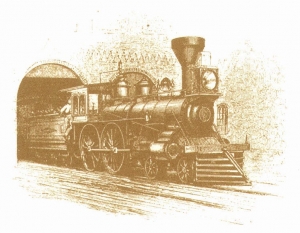 population within the corridor, 24 million compared to 70 million. Furthermore, California has a bi-polar distribution with more than 95 percent of the total population concentrated at the ends of the corridor. In contrast, the Japanese high-speed rail corridor contains a nearly continuous conurbation of dense population centers. These differences suggest that a high-speed rail line in California is going to be critically dependent on its ability to compete for trips between the two big metropolitan nodes at Los Angeles and San Francisco (350 miles by air, 425 miles by highway and rail). In contrast the Japanese system serves markets that are separated by much shorter distances. The variety of market distances in that corridor allows the Japanese system to take advantage of skip-stop scheduling and to serve a large number of city pairs without much loss of the economies-of-density.
population within the corridor, 24 million compared to 70 million. Furthermore, California has a bi-polar distribution with more than 95 percent of the total population concentrated at the ends of the corridor. In contrast, the Japanese high-speed rail corridor contains a nearly continuous conurbation of dense population centers. These differences suggest that a high-speed rail line in California is going to be critically dependent on its ability to compete for trips between the two big metropolitan nodes at Los Angeles and San Francisco (350 miles by air, 425 miles by highway and rail). In contrast the Japanese system serves markets that are separated by much shorter distances. The variety of market distances in that corridor allows the Japanese system to take advantage of skip-stop scheduling and to serve a large number of city pairs without much loss of the economies-of-density.
- Competitive Time and Money Costs: Unlike those in Europe and Japan, high-speed rail in California would face two formidable competitors in terms of time and cost: both air and highway travel are relatively cheap in California. Gasoline prices in Europe continue to be three to four times higher than in the United States. Freeway tolls in many European corridors, including those served by the French TGV, are quite high and add significantly to the cost of driving (for example, the toll from Paris to Lyon is about $40). Airfares in Europe are at least twice those in California, and the situation in Japan is even more extreme.
Not only are the costs of air and highway travel much higher in Japan and Europe than they are in California, but so are travel times. European intercity freeways are heavily congested, and many of the corridors served by high-speed rail do not enjoy anywhere near the freeway capacity available in the California corridor. Air travel is also considerably faster in California, where frequent flights provide service with virtually no schedule delay, an important element of time cost in short-haul transportation. (There are currently more than 200 flights per day between Los Angeles and the Bay Area, 70 per hour during the evening peak. Discounted fares today are below $50 per trip, making this the lowest priced corridor in the world.)
If high-speed rail is to compete effectively against these other modes it will have to offer matching services at competitive prices. And in California, high-speed rail needs to be cheaper and faster than the systems in Europe and Japan.
- Efficient Local Distribution for Quick Access to the Service: An essential element of the time competitiveness of the rail system is the collection and distribution necessary at the ends of the line-haul service. Like air transportation, rail requires major infrastructure for intermodal transfers, and it depends on an effective distribution system to provide quick access to and egress from its terminals. This factor plays against rail in California as compared to Europe and Japan in three ways. First, California’s urban areas to be connected by rail are much less dense than those in either Europe or Japan. Second, local distribution systems in California are not as well connected. For example, TGV connections in Paris stations coincide with those of two local distribution systems – the Paris Metro and the regional RER train system. These bring the whole metropolitan region within easy access of the TGV line. In contrast a high-speed rail terminal in the San Francisco Bay Area would be connecting to a disjointed, less efficient, and less ubiquitous public transportation system, making it more dependent for its access on congested urban freeways. Third, the abundance of competing airports in the California corridor presents rail with additional challenges not faced in Europe and Japan. With the San Francisco Bay Area served by three and the Los Angeles
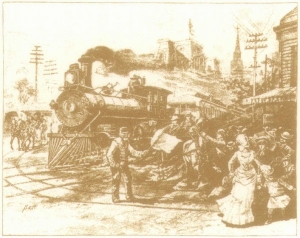 Basin by five airports, there is no reason to believe that access to rail stations is likely to be any easier than to airports. Given the line-haul speed disadvantage of rail when compared with air, the rail system is going to have to provide significantly better access if it’s to be competitive.
Basin by five airports, there is no reason to believe that access to rail stations is likely to be any easier than to airports. Given the line-haul speed disadvantage of rail when compared with air, the rail system is going to have to provide significantly better access if it’s to be competitive. - Network Effects: Unless population densities along the corridor are high, as in Japan, traffic between the ends of the corridor is not sufficient by itself to sustain a high-speed rail link. The link must be part of a larger, connected rail network. The success of Japan’s high-speed rail comes from both the very high population densities and the consequent large demands generated along the corridor and then to the network of public transport connections to off-line cities. In Europe, too, high-speed rail has been successful because cities along the routes are close together and rail networks spread outward from each high-speed station. Thus, end points of the TGV line act as transfer centers, much as airline hubs do. This relationship is illustrated by the traffic figures on the Paris-Lyon line, where only about 5 million of the more than 20 million annual passengers travel between the TGV line’s end points; the rest connect to other points in the network. Without feeding into a supportive network, it’s doubtful that even the highly successful TGV-Atlantique would have survived. Within a four-hour high-speed-rail trip time, the European network encompasses an area with a population of more than 150 million.
California’s geography raises serious questions about the potential for network effects. First, the corridor traces through a sparsely populated region, primarily devoted to agriculture, except for the metropolitan developments at either end. The vast distances separating the California corridor from population centers elsewhere, say in Nevada and Arizona, also reduce network possibilities for a rail system, leaving the advantage to air transportation.
- Institutions: California’s passenger rail system is currently pretty sparse. To operate a high speed rail system in California efficiently will require rebuilding institutional capabilities lost in past decades. In Europe and Japan, the institutions that operate and regulate rail transportation managed to implement high-speed rail by gradually and marginally increasing speeds over a period of time. In California, such an incremental approach would pose an institutional challenge that would be difficult to meet within the time horizon envisaged for the system. The danger of proceeding with inadequate institutional infrastructure is that the system will fail to meet its operational goals and consequently fall short of capturing its market share.
HOW TO PROCEED-SLOWLY
Market penetration possibilities in California do not match those in Europe and Japan. TGV captures 90 percent of the traffic between Paris and Lyon, despite its 50-minute line-haul time disadvantage when compared to flight; but so large a market share is wholly unlikely in California. The European intercity transportation system is trimodal, with automobiles dominating over short distances in the range of 120 miles (200 km), rail dominating in the range of 120-360 miles (200-600 km) and air in the range beyond 360 miles (600 km). In California the system tends to be bi-modal, with highway and air between them competitively covering the whole range of distances.
Does this mean that high-speed rail is not a good option for California? Or are there other compelling reasons to build the system nevertheless? Despite the conventional wisdom, congestion is not the reason to build a high-speed train. The intercity transportation system in California is not congested, nor is it likely to become so for the reasons discussed above. Congested air space would be minimally influenced by a diversion of traffic to rails because corridor flights represent only a fraction of the traffic at the congested airports (7 percent of Los Angeles International Airport’s capacity in 1993!) .
TRANSEUROPEAN HIGH-SPEED NETWORK (LONG-TERM MASTER PLAN)
European high-speed rail is successful in part because it relies on a supportive network of cities connected by existing rail. Much of the planned high-seed system will consist of upgraded lines.
Besides, passenger traffic can be readily increased without increasing numbers of flights and without losing schedule convenience: simply increase aircraft size. Perhaps the most convincing argument for rail is its environmental advantages and possible energy efficiency. However, again, these advantages can be gained only if the system is operated at a high enough level of efficiency. That is, enough passengers must be on board to make energy consumption and pollutant emission levels per person per mile less than automobile and airplane levels. What those numbers might be in California, and whether they justify building a high-speed rail remains an open question.
Rail might also be seen as a potential means for enhancing accessibility to the intermediate regions within the California corridor. The Central Valley is not adequately served by air transportation, mostly because the commuter air market is not as adaptable and competitive as the rest of the air carrier system. If high-speed rail, or indeed any rail, would effectively generate regional development there, then it may be worthwhile to implement policies to make that technology feasible, including creating subsidies to sustain the technology until it can pay for itself. It may take $4 a gallon for gasoline or $200 in corridor airfares to create a consumer market for high-speed rail. But it seems unlikely that such policies, which have worked to the advantage of rail transportation in Europe and Japan, will ever gain the necessary political support in California.
Many questions remain unanswered and unanswerable with the information we have in hand. We know very little about the total costs of rail, or of other technologies for that matter. There has not been a study of the total social costs of intercity transportation in California. Policy makers cannot even compare the full cost of building the rail system with that of expanding the capacity of alternative modes. Likewise, we know very little about the nature of the demand for intercity transportation in the state.
The decisions to deploy high-speed rail technology in California cannot be rushed. Careful study of important issues is needed to inform public opinion and to support responsible decision making. Therefore, before rushing to build, we must take time for more careful and dispassionate study.
REFERENCES
A. Bonnafous, “The Regional Impact of the TGV,” Transportation 14:127-137 (1987).
P. Hofstetter and F. Meienberg, Une comparaion écologique et économique entre différents moyens de transport, sur la base de sept destinations européennes, I’ Association transports et environnement et SSR Voyages (October 1 992). éÇ
A. Kanafani and W. Youssef, “Roles and Market Share: The Interaction between Air and High Speed Rail Transportation in California,” ITS Research Report, UCB-ITS-RR- 93-6 (May 1993).
G. Mathieu, New High Speed Rail Developments. France’s Master Plan, Societé nationale de chemin de fer français (1992).

